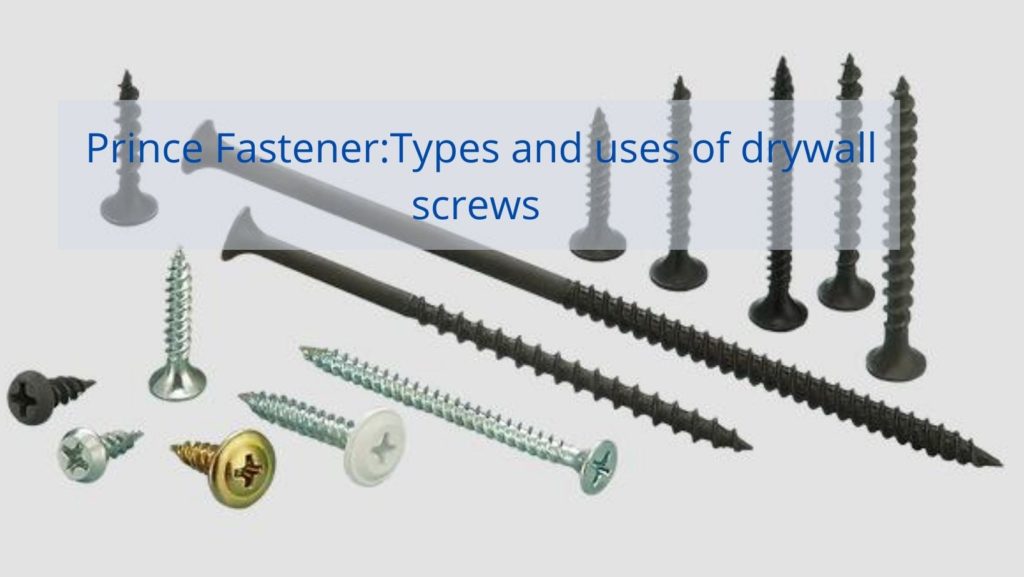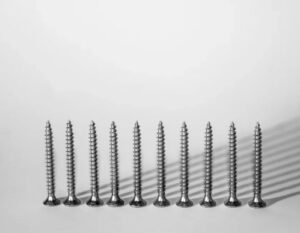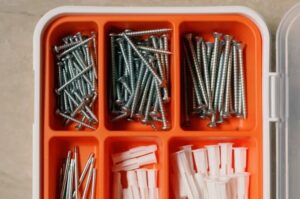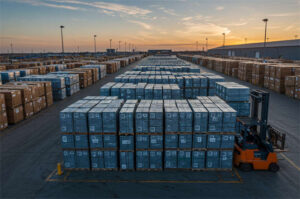Prince Fastener:Types and Uses of Drywall Screws
Drywall Screws
Drywall screws are used to attach drywall panels to studs or ceiling joists. Compared to regular screws, drywall screws have deeper threads. This helps prevent the screws from easily falling out of the drywall screws.
Drywall screws are made of steel. To drill them into the wall, a power screwdriver is required. Sometimes plastic anchors are used together with drywall screws. They help balance the weight of the hanging object so that it is evenly distributed on the surface.
Drywall screws
Types of Drywall Screws
The two common drywall screws are Type S, and Type W. Type S screws are suitable for attaching drywall screws to metal. Type S screws have thin threads and a sharp tip, making the surface easier to penetrate.
On the other hand, Type W screws are longer and thinner. This type of screw is designed for installing drywall screws in wood.
Drywall nailer boards are usually available in different thicknesses. Type W screws are typically driven into the wood to a depth of 0.63 inches, while type S screws are driven to 0.38 inches.
If there are multiple layers of drywall screws, then the screws should be long enough to drive at least 0.5″ into the second layer.
Most installation guides and resources identify drywall screws as Type S and Type W, but in most cases, drywall screws are identified only by their thread type. Drywall screws either have a coarse thread or a fine thread.
Thread or Pitch of Drywall Screws
The pitch of a drywall screw is mostly classified as either coarse or fine thread. If the screw has a coarse thread, it will be held tighter. Since the threads are fewer, it takes a short time to screw them into place. Here is an example of a coarse threaded drywall nailer. SNUG Fasteners (SNG440) 145 count #8 x 2 Sheetrock Wall Screw – Coarse Threaded Phillips Head
Drywall panel screws with fine threads take longer to insert, but the screws are easier to insert because they have sharper points. Here is an example of a drywall stud board screw with a fine thread. Gray phosphate drywall screws. #6 x 1-5/8″ (5 lb., approx. 1,134 screws) fine-threaded drywall screws (or drywall screws).
If you are attaching drywall screws to cork studs, you should use coarse threaded drywall screws. When attaching drywall studs to light metal studs, you should use fine-threaded drywall studs.
There are also specialized screws that are designed for specific applications. These are used for attaching drywall studs to heavy metal studs. The drywall screws you need to use here are self-drilling drywall screws. Self-drilling screws do not require prior drilling. For an example of a self-drilling drywall screw, consider this. u-turn – 6 x 1-5/8 inch metal stud self-drilling drywall screws (100 pack)
Coarse thread drywall screws are good at gripping into wood due to their wide threads. This allows the drywall nail to be pulled into the studs. If used on metal, this screw tends to chew through the metal and does not get the proper traction. Since fine thread screws are self-threading, they work well with metal.
Drywall Screw Size
Length of drywall screws
If you are using 1/2 inch drywall screws on wood studs, zui is better to use 1-1/4 inch or 1-5/8 inch drywall screws. You can purchase these screws in large tubs because you will need many fasteners when doing drywall nail installation work. These types of screws are not expensive.
Shorter screw lengths will make driving easier. However, shorter screw lengths will also reduce holding strength.
For ¼” drywall screws, use 1-1/4″ drywall screws. For 1/2″ drywall studs, use 1-1/4″ or 1-5/8″ drywall studs. If the drywall nail is 5/8″, use 1-5/8″ or 2″ drywall screws.
Drywall screws usually have 1/2″ thick panels. However, the thickness can be increased or decreased by a fraction of an inch. If you are installing drywall screws in garages and walls adjacent to fireplace rooms, you will need slightly thicker panels to ensure that the spread of flames will be impeded in the event of a fire. In this case, you will need 5/8″ or x-shaped drywall screws.
¼” drywall nailer panels are used for walls and ceilings. These walls are flexible, so it can be used to form curves. However, most drywall screws installed are 1/2″ thick.
Drywall screws manufacturers
Dimensions of Drywall Screws
When we talk about the specifications of drywall stud board screws, we are referring to the diameter of the screw. Use whole numbers for specifications. zui common numbers are #6, 7, 8, and 10. most of the time, you will use #6 and #8 drywall screws. As the diameter of the screw gets larger, the specification number increases. Therefore, a #6 drywall screw will have a smaller diameter than a #8 drywall screw.
For the actual size of the drywall screw specification, the size 6 is 0.1380″, and the size 8 is 0.1640″.
Specifications are usually expressed as the second number after the length. For example, a #6 gauge screw that is 1-5/8″ long could be written as 1-5/8″ x 6. Here is an example. Grip-Rite 158CDWS1 1-5/8″ #6 coarse thread drywall screw, 1 lb.
The standard material for drywall screws is mild steel. To protect the screws from corrosion, they are sometimes coated with gray or black phosphate. This is sufficient to prevent water-based coatings from forming rust before they dry.
Features of drywall screws
The head of a drywall screw is shaped like the bell end of a bugle. This is why it is called a military bugle head. This shape helps the screw stay in place. It helps not to tear the outer paper of the drywall nail. With the bugle head, the drywall nail can be easily embedded into the drywall nail. This creates a recessed surface filled with filler and then painted to make the surface smooth.
Some drywall screws have sharp tips. With a sharp tip, it’s easier to drive the screw into the drywall paper and get it started.
Sometimes, if you buy a large box of drywall screws, you measure the weight rather than the number of screws. Take this as an example. Metric #6 Coarse Wire Drywall Screws, 1-1/4″ leg length with flared head, 5 lb. black #DSC114M (1 box)
Most drywall screws typically require a #2 Phillips head bit. While other construction screws have been using Torx square or heads instead of Phillips heads, most drywall screws still use Phillips heads.
To resist corrosion, black drywall screws have a phosphate coating. Other drywall screws have a thin vinyl coating that makes them more resistant to corrosion. Because these screws have slippery shanks, they are very easy to draw in. Here is an example of a black drywall screw with a phosphate coating. (10,000) #6 X 1/2″ drywall screw cross recessed head thick wire black phosphate bulk box
Drywall screws drawing
Uses of Drywall Screws
Drywall screws are primarily used to secure whole or partial drywall sheets to wood or metal studs.
Drywall screws are also suitable for repairing nail pops. A nail burst is a round bump you see on the wall. These are the short, wide screws used to hold drywall screws in place. Due to the problem of nail pops, drywall screws have been replaced by drywall studs as the standard method of attaching drywall screws to studs.
You can also use drywall screws in construction projects. Since drywall screws are quite brittle, they can break rather than bend. It is easy for the head to break off and embed the displaced portion in your wood. This is why drywall screws should not be used for heavy or moderate construction tasks. You should avoid using drywall screws for outdoor projects such as fences and decks. You should only use drywall screws for light construction projects.
Drywall screws can also be used for carpentry projects. When working with softwood, drywall screws are perfect for thick lines.
Cabinet installers also use drywall screws to install and physically fabricate cabinets. Drywall screws typically used for cabinet installation have a yellow galvanized coating. This yellow galvanized coating looks great with the wood. It also provides additional corrosion resistance to the screw. Here is an example of a drywall nail with a yellow zinc coating.
Here are some improper uses for drywall screws
You should not use drywall screws outdoors, especially in wet areas.
It is not suitable for use on your outdoor deck.
It is not safe to use drywall screws to install an electrical box on your ceiling that supports a ceiling fan.
Do not use drywall screws to secure stair frames, whether indoors or outdoors.
Never use drywall screws to secure a balustrade to a handrail.
Drywall screws Uses
How do I use drywall screws?
To use drywall screws, you will need a special drywall nail gun. This is a special tool for hanging drywall screws. It is compact, lightweight, and has a lower torque than most cordless drills. The screwdriver should be paired with a drywall nail bit. With a drywall bit, the screw will sit at the correct depth. This will allow it to be filled and coated.
The proper size drywall nail should be selected. Make sure the screws are at least 10 mm longer than the thickness of the drywall studs.
The location of the studs should be marked out. You will need to lift the drywall stud board into the correct position. The screws should be more than 6.5 mm from the edge of the wall.
Adjust your screwdriver so that it is set to the right depth. Then place the finishing drywall board screws on top.
While holding the screw gun, hold the drywall screws tightly and place the screws in place. Drive the screws into the gypsum board and substrate.
To properly drive in the drywall screws, use the tip of the screw to pierce the exterior wallpaper. Place the drill bit on the screw, open the bit and let the screw drill itself into the drywall nail and studs. To prevent the screw from protruding, apply more force as it penetrates three-quarters of the way through.
When you see the head level with the paper, you need to stop. To get the screw to sink just under the paper, turn the screw another quarter or half turn.
The screws should be 12 inches apart. This means that when hanging 48 inches of paper perpendicular to the studs, you will need about 5 screws.
You will need to consult your local building codes to determine the tightening spacing for your drywall screws.
The difference between wood screws and drywall screws
To make your project a success, it is important to match the screws to work at hand. You only need to look at the name of the screw to know what material the screw is used for. Thus, drywall screws are used to secure drywall panels to wood or metal framing. Wood screws are used to fasten pieces of wood.
If you use stainless steel, flat head wood screws, you will need slotted or Phillips head screwdrivers.
Wood screws are galvanized steel, stainless steel, silicon, bronze, and brass. Drywall screws, on the other hand, are made of case-hardened steel. Drywall screws are usually black because they are treated with black phosphate on steel.
Wood screws have no threads below the screw head and feel smooth. This smooth section of the wood screw slides over the top half of the wood’s edge so that the screw head and threads can hold the two pieces of wood together. With drywall screws, almost all of the threads are in the head.
When using wood screws, a lot of preparation is required. A pilot hole needs to be drilled for the threads beforehand. You will also need to drill a wider hole for the length of the shaft that is not threaded. In addition, there is a countersink hole for setting the head.
Drywall screw size
Wood screws are numbered from 0 to 20. this means the diameter is from 1/16″ to 5/16″. Wood screws are numbered in inches, from 1/2″ to 4″ in length. Drywall screws are numbered from 6 to 10. These numbers indicate the number of threads per inch.
Wood screws have different heads corresponding to the type of drive needed to install them. It also indicates the purpose of the screw. The different screw heads include slotted, Phillips, flat, oval, and round head screws. Drywall screws have worm heads. These heads are set a little below the surface of the drywall nail.
You will need a pilot hole to get the wood screw started. Drywall screws have hard, sharp teeth that allow them to self-start. Self-tapping screws do not require a pilot hole. You can drive them directly into the drywall screws with a hand screwdriver or electric driver.
If you want to install drywall screws in wet areas, you need green board drywall screws. Greenboard drywall screws are waterproof. It has a plaster core that has been treated with silicone-like water repellent. It also has moisture-resistant outer paper.
To secure your green board drywall screws to the studs, you must use galvanized drywall screws. Your green board should be coated with water-based polyurethane before you finish the green board.
With galvanized drywall screws, you can install your green board drywall behind sinks, toilets, and walls with tile backdrops.
Using hot-dipped galvanized fasteners or stainless steel screws will prevent them from rusting. You can use these to secure your drywall pegboard to wall studs and ceiling joists. Using raw steel screws will rust over time. With rusty screws, your wall panels will fall off the walls or ceiling.














